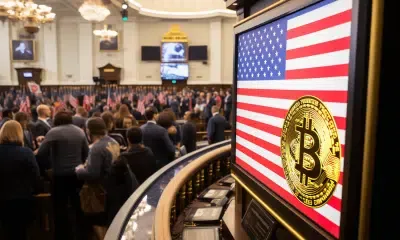
Wrapped Bitcoin (WBTC) represents a significant crypto breakthrough, created so Bitcoin’s vast liquidity and market clout could flow into Ethereum’s bustling Decentralized Finance (DeFi) scene, and increasingly, onto other blockchain platforms. Functioning as an ERC-20 token, one WBTC is designed to match the value of one Bitcoin (BTC), with actual BTC held by designated custodians providing the backing. This wrapping technique untethers Bitcoin from its own blockchain, enabling it to dive into a wide array of applications run by smart contracts.
Why WBTC Was Born: Freeing Bitcoin for DeFi
Even though Bitcoin kicked off the crypto wave and is a major way people store value, it doesn’t offer much in terms of smart contract capabilities or easy connections with other blockchains. This shortcoming historically kept its huge pool of money separate from the rapidly expanding DeFi world, which mostly grew on Ethereum.
WBTC appeared in January 2019, thanks to a joint effort from organizations like BitGo, Kyber Network, and Ren (which used to be Republic Protocol), aiming to close this gap. By making Bitcoin usable as an ERC-20 token, WBTC allows Bitcoin owners to tap into DeFi services without needing to sell their original BTC.
Who’s Who in the WBTC World
For WBTC to function smoothly, several key groups work together:
- Custodians: These are trusted financial institutions that securely hold the actual Bitcoin that backs WBTC. BitGo has largely filled this role, though this setup is changing. Custodians are in charge of creating new WBTC when BTC is deposited and destroying WBTC when it’s redeemed for BTC. They’re essential for making sure the 1:1 backing is real and provable. Around late 2024 and into 2025, BitGo has been diversifying how it handles WBTC custody, including link-ups with firms like BiT Global and operations in places such as Hong Kong and Singapore, all to boost security and navigate regulations better.
- Merchants: These are the middlemen who help users turn BTC into WBTC (a process called wrapping or minting) and WBTC back into BTC (unwrapping or burning). Merchants take care of Know Your Customer (KYC) and Anti-Money Laundering (AML) checks. Kyber Network and Republic Protocol were among the first well-known merchants. People go through merchants to get their BTC converted to WBTC, or their WBTC back to BTC.
- Users: This refers to any person or system holding WBTC. They use it on Ethereum for many DeFi purposes, like lending, borrowing, adding funds to decentralized exchanges (DEXs), or trying out yield farming. Many also just buy WBTC on regular crypto exchanges.
- WBTC DAO (Decentralized Autonomous Organization): The WBTC system’s rules and direction are guided by the WBTC DAO. This group, made of various member organizations, collectively controls a multi-signature contract. They approve updates to the system and decide which organizations can act as merchants or custodians. Reports suggest the DAO now counts over 30 members.
How It Works: Making and Unmaking WBTC
Creating WBTC (Wrapping BTC):
- A person starts by asking an approved merchant to change their BTC into WBTC.
- The merchant then performs the necessary KYC/AML identity checks.
- The person sends their BTC to the merchant, who in turn sends it to a custodian.
- The custodian confirms the BTC deposit and then creates the same amount of WBTC tokens (after any fees) on the Ethereum network.
- These new WBTC tokens are sent to the merchant, who passes them on to the person’s Ethereum address.
Getting BTC Back (Unwrapping WBTC):
- Someone holding WBTC who wants actual BTC back contacts a merchant.
- They send their WBTC to that merchant.
- The merchant triggers a “burn” for the WBTC, sending it to a special address. This takes the WBTC out of circulation and lowers the total supply.
- The custodian checks the Ethereum blockchain to see that the burn happened.
- Once it’s confirmed, the custodian releases the equivalent BTC from their reserves to the merchant, who then sends it to the person (minus any fees).
Fees for these services can differ between merchants; CoinList, for example, has charged about 0.25% in the past. Custodian fees are generally lower.
Tech and Safety Behind WBTC
Several core elements make WBTC work and keep it secure:
- ERC-20 Standard: WBTC follows ERC-20 rules, so it fits right in with Ethereum wallets, smart contracts, and decentralized apps (dApps).
- Proof of Reserves: Transparency is vital. The system allows anyone to check the BTC reserves held by custodians, confirming that all WBTC in circulation is truly backed. This often uses on-chain data and tools like Chainlink Proof of Reserve, which BitGo adopted for automated, live reserve checks. The official wbtc.network website also shows this proof-of-reserves data.
- Smart Contracts: The creation, destruction, and movement of WBTC are all handled by smart contracts on Ethereum. These contracts have been thoroughly checked for weaknesses by independent security auditors like ChainSecurity and Solidified.
- Interoperability: WBTC was fundamentally designed to let Bitcoin connect with Ethereum’s DeFi services, thereby letting Bitcoin’s considerable value flow into Ethereum-based financial tools.
- Speed and Cost: Using WBTC on Ethereum can sometimes be faster and potentially less expensive than native Bitcoin transactions, though this varies with Ethereum network traffic. Ethereum blocks are typically confirmed in about 12-15 seconds, much quicker than Bitcoin’s roughly 10-minute block time.
- Governance Security: The WBTC DAO’s multi-signature contract, which historically needed a certain number of members (for instance, 8 out of 13) to approve changes, adds a layer of security to prevent any single entity from having too much control.
However, depending on custodians creates counterparty risk, a major point of concern for WBTC. If a custodian suffers a hack, goes bankrupt, or acts improperly, the BTC backing WBTC could be lost.
WBTC’s Role in DeFi: Common Uses
WBTC has found its place in many DeFi applications:
- Loan Collateral: People often use WBTC as collateral to borrow funds or mint stablecoins like DAI on platforms such as MakerDAO, Aave, and Compound.
- Liquidity for Exchanges: WBTC is a popular choice for those who provide liquidity to decentralized exchanges (DEXs) like Uniswap, Curve Finance, and Sushiswap, allowing them to earn trading fees and other rewards.
- Yield Farming: Bitcoin owners can change their BTC into WBTC to jump into various yield farming opportunities, which might involve staking LP tokens or lending out their WBTC.
- Trading on DEXs: WBTC makes it possible to trade Bitcoin against many different ERC-20 tokens on decentralized platforms.
Market Impact: How Much WBTC is Used
WBTC has gained a lot of traction in the market. Around mid-May 2025, its total market value was quite large, with numbers around $13.3 billion being mentioned. Trading activity often hits hundreds of millions of dollars daily, with recent figures showing $300-360 million in 24-hour volume.
The Total Value Locked (TVL) in WBTC also highlights its significance. This isn’t the same as market cap but shows the value of Bitcoin locked up to create WBTC. In November 2024, the TVL for WBTC was reportedly over $13.5 billion.
Understanding the Risks and Downsides
Even with its achievements, WBTC comes with certain dangers:
- Counterparty and Centralization Risk: The biggest worry usually mentioned is the need to trust centralized custodians like BitGo. This creates a single point where things could go wrong and clashes with Bitcoin’s original idea of being decentralized. Recent changes to how BitGo handles custody, including a joint venture with BiT Global linked to Justin Sun, raised more red flags, causing some platforms like MakerDAO and even Coinbase to rethink their use or support of WBTC.
- Smart Contract Flaws: Even though they are audited, smart contracts might still have hidden bugs.
- Shifting Regulations: The rules for wrapped assets and DeFi are still developing, which could create problems. Areas like the EU (with its MiCA rules) are putting in place broad regulations that might affect wrapped tokens.
- Market Swings & Peg Issues: WBTC has mostly stayed pegged 1:1 to BTC, but there have been small de-pegging moments, especially when the market is extremely chaotic or due to problems on certain exchanges. A quick, sharp drop on Binance in November 2024 saw WBTC’s price dip a lot for a moment, but this was blamed on a tech issue and wasn’t a widespread de-pegging.
The Bigger Picture: WBTC and Other Options
While WBTC is the leading solution, it has rivals like tBTC (Threshold Bitcoin), which tries to use a more decentralized approach to custody, and formerly renBTC. The Lightning Network provides another way for Bitcoin to be used across chains, mostly for payments and quick swaps, not so much for DeFi collateral in the way WBTC is used. Each option comes with different levels of trust needed and different ways of working.
Governance, Openness, and What’s Next
How the WBTC DAO is run and how openly its Proof of Reserves are displayed are key to keeping people’s trust. Users can usually check the reserves using block explorers and special websites. Still, the move to custody arrangements spread across different countries has led to more questions about control and transparency.
Looking ahead, WBTC will probably keep working on becoming more decentralized, show up on more blockchains (it’s already on chains like Avalanche, Polygon, and BNB Chain), and adapt to the ever-changing regulatory world. It plays a big part in helping different blockchains work together, making the crypto world more connected. However, the risks that come with its large market share and reliance on custodians need constant watching.
For everyday users, getting WBTC is usually easiest through exchanges. Creating it directly involves KYC/AML steps and can be more involved. Using WBTC in DeFi opens up many chances but also means understanding risks like Ethereum gas fees, which can swing wildly.
Big-picture economic events, like changes in interest rates and inflation, plus major shifts in the Bitcoin market, all have a direct effect on how much WBTC is wanted, how stable it is, and how useful it is in DeFi. How these things connect shows why WBTC is a vital, but closely watched, part of the digital money landscape.




